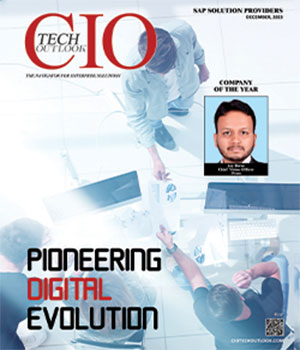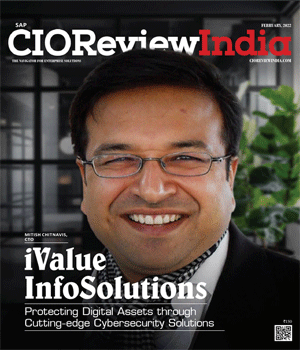
Secure Your Cloud Investments with the Right Integration Technologies
Sunil Mehra, Vice President, Middleware, Oracle India | Tuesday, 07 June 2016, 06:24 IST
 The cloud revolution has become a reality. As India moves up the value chain as a key provider of cloud solutions (emergence of several IT start-ups who have based their computing model on cloud) and a frequent consumer of cloud solutions (buying and selling online, growth in Internet usage on mobile, citizen services delivered online, private sector deploying cloud in private or public cloud form etc.), the market opportunity for cloud is immense.
The cloud revolution has become a reality. As India moves up the value chain as a key provider of cloud solutions (emergence of several IT start-ups who have based their computing model on cloud) and a frequent consumer of cloud solutions (buying and selling online, growth in Internet usage on mobile, citizen services delivered online, private sector deploying cloud in private or public cloud form etc.), the market opportunity for cloud is immense.
Add to this the rapid shift from on-premise applications to a hybrid mix of Software-as-a-Service (SaaS) and on-premise applications which has given rise to big challenges for companies attempting to simplify enterprise application integration. One reason for this challenge is the ease in which Lines of Business (LOBs, such as marketing, sales, customer support, finance etc.) can subscribe to multiple disparate SaaS applications with little or no involvement from internal IT. Once the LOB starts using the SaaS application however, there is often a need to integrate with existing applications. Until now integration platforms have been too complicated to easily include participation with LOB application users, resulting in a costly, time consuming, and error prone attempt at integration.
Cloud promises to revolutionise the government and private sectors as they offer tremendous opportunity to improve healthcare, education and manufacturing sectors, to name a few. Why then, are companies, not able to leapfrog into it? An Oracle survey has thrown up surprising results. It has found that many companies have abandoned transitioning to the cloud in the last three years due to cloud integration challenges. In the absence of the right cloud integration solution, 54 percent missed project deadlines and about 42 percent saw data security breaches in their departments.
What does this say?
There is no denying that alternate computing models like cloud is the future of IT. Which other technology offers the agility, scalability, affordability, device agnostic option access as cloud does? Not to forget faster implementation cycles, low capex, lifelong support and a future for growth. It is critical, therefore, for organisations, to implement various cloud solutions with a well planned and thought through strategy that will enable the easy integration of cloud with competing cloud solutions or on-premise solutions and maintain the highest standard of security.
Here are Seven tips to help you choose the right cloud integration solution:
1. Simplicity- It is important that the cloud integration solution be easily implemented. Until recently, most integration tools were too complicated for users, resulting in a costly delays and error-prone attempts at application integration.
2. Monitoring Dashboard -This is essential since a rich monitoring dashboard can provide real-time insight into transactions that can help companies significantly shorten time to market through a highly intuitive user interface and a library of SaaS connectors.
3. Scalability- One of the biggest advantages of cloud solutions is that companies can easily scale as per their requirements. The same goes for cloud integration, organizations should choose an integration solution which provides them with options to easily scale up or down.
4. Extending the life cycle of legacy systems- Tight integration between cloud and on-premises applications is critical so that companies can extend the life of their legacy systems and tap into rich data stores.
5. Pre Built Integration- Organizations should choose cloud integration solutions which offer the option of prebuilt integration to help jump start the application.
6. Investing in the right cloud platform- The right Software as a Service (SaaS) and Platform as a Service (PaaS) solution ensures that the source and target are integrated in a more systematic manner.
7. Total cost of ownership- Most of the cost of enterprise software lies in operations – the people and effort it takes to keep the software running. With a tight integration solution at each layer of the cloud stack, there is a lesser need for specialized middleware and expensive resources, thus reducing the total lower the total cost of ownership for organizations.
With the help of the right cloud integration solution, organizations can transform their fragmented company into a connected cloud business. It provides advantages to different line of businesses by providing real-time customer data, synchronization of cloud with on-premises applications for marketing, and connects customer support applications with the
sales applications.
In a nutshell, a good cloud integration solution offers simplicity in usage, high speed, data scalability, connectivity and a great user experience - all of which are essential for transitioning to the cloud.
CIO Viewpoint
The Challenge: Leveraging Existing Technologies
By Alvina Antar, CIO, Zuora
Business and Data Analytics to Achieve...
By Todd Simpson, CIO, FDA
Real World Experiences and Lessons Learned With...
By David Whittle, CIO, Bokanyi Consulting
CXO Insights
Prasa: A Pioneer in Offering Precise Solutions...
By Jay Burse, Chief Vision Officer
SAP, the Digital Future Navigating Business...



.jpg)
.jpg)






